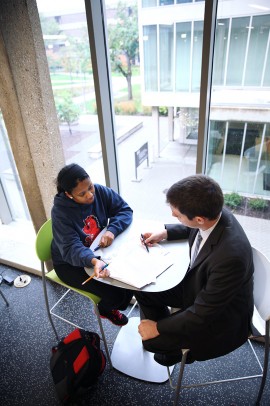Identifying what makes students successful

UIC’s Student Success Plan outlines areas for improvement in areas such as support for student learning, financing college and student life.
What factors play a role in undergraduate student success and failure?
What works and what doesn’t when considering variables such as ACT score or high school grade point average as predictors of future college success?
Answers to these questions are being sought at UIC through ongoing data collection and analysis as part of the campuswide Student Success Plan.
The planning initiative, launched in 2012 by Lon Kaufman, provost and vice chancellor for academic affairs, and Barbara Henley, vice chancellor for student affairs, aims to identify areas for improvement in eight strategic areas related to student success: data analysis and assessment, targeted first-year curriculum, support for student learning, faculty engagement, advising, financing college, campus life and pre-matriculation issues.
Recommendations developed by task forces of more than 200 students, faculty and staff will help guide future institutional strategies to bolster student support and improve graduation rates.
“UIC is similar to its peers in terms of the performance of comparable cohorts of undergraduates,” said Bette Bottoms, vice provost for undergraduate affairs and dean of the Honors College, who oversaw the task forces with Linda Deanna, associate vice chancellor for student affairs and dean of students.
“But our mission is different from many of our peer institutions, and therefore many of our students are different.
“We proudly provide access and a pathway to success for a diverse range of students.”
While UIC’s six-year graduation rate has risen over the last 15 years from 31 percent to 57 percent, Bottoms and campus administrators want to see the progress continue with greater parity among underrepresented groups.
Others outside the university have already noticed UIC’s efforts, particularly the data analysis component where statistical models are being developed to understand the factors predicting student success.
An anonymous foundation that serves low-income students from Chicago Public Schools awarded Bottoms and UIC a $400,000, two-year grant to expand data analysis and collection efforts beyond the campus.
“They like the way we are setting policy based on data, but challenged us to think even bigger and broader,” Bottoms said.
“Out of that came our idea to bring all the other area colleges and universities together to start talking about student success.”
The Chicago Collaborative for Undergraduate Success is a result of the funding, which also supports two specialists — one in data analysis, the other in program development — and a professional meeting facilitator.
The collaborative, led by Bottoms and UIC, brings together representatives from local colleges and universities to share best practices and data to help all institutions increase undergraduate success in Chicago.
Bottoms said the group’s overall objective is twofold.
“First, we come together to understand what we can do on our campuses to increase student success,” she said. “Second, we will collaborate with Chicago Public Schools to help them better prepare their students for college.”
The group’s first meeting in October included vice provost-level representatives from Associated Colleges of Illinois, City Colleges of Chicago, DePaul University, Illinois Institute of Technology, Loyola University, Northwestern University, the University of Chicago, the Consortium on Chicago School Research and the City of Chicago.
Participants described their institutional and student profiles, shared best practices for supporting student success and discussed potential projects.
Although the initial core focus will be first-year college success, Bottoms expects the collaborative to address practical issues such as elementary and high school curriculum changes, as well as new pathways for community college students to four-year institutions.
“For example, the Common Core Curriculum is going to change the way writing and math are taught in high schools and grade schools,” she said.
“It has implications for how we and other universities do placement testing and how students come prepared or not to initial classes.”
While group members have their own institutional identities, many of their issues will be similar, Bottoms said.
“This alliance could give us an easier, more efficient way of talking with one another about shared goals and of working more closely with high schools.”
As research moves forward, Bottoms said additional universities and the Chicago Public Schools will join the group. Northeastern Illinois University, Columbia College and Roosevelt University are the newest members.
“The data from the collaborative will help high schools better understand the performance of their students in college and thereby inform their programs and policies related to college readiness,” she said.
“It’s a model that will bring everyone to the table and give us the power to help many Chicago youth be successful in college and beyond.”
